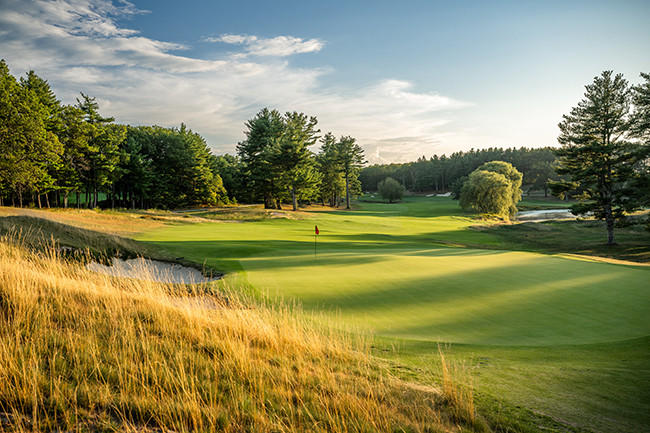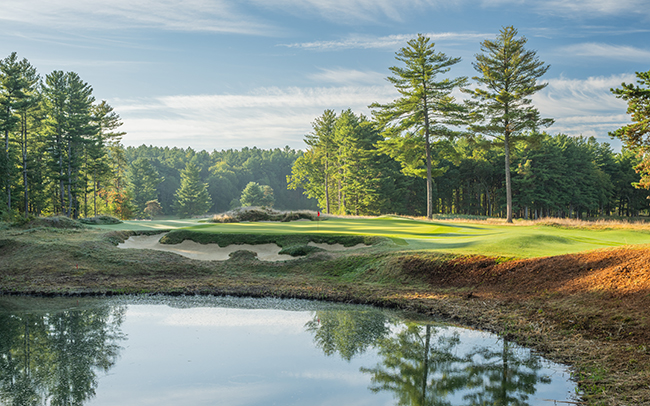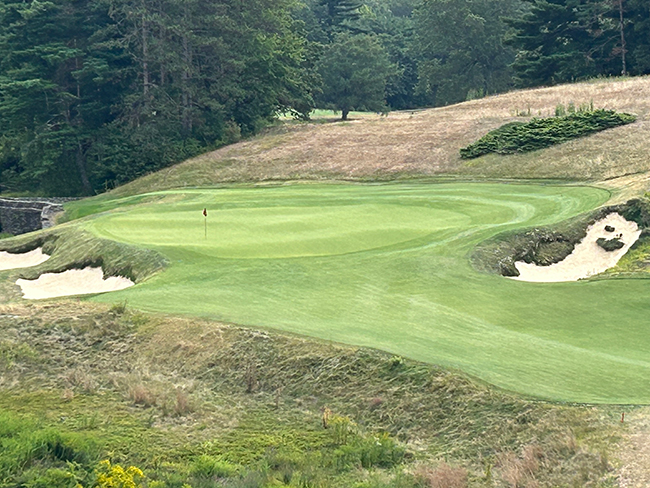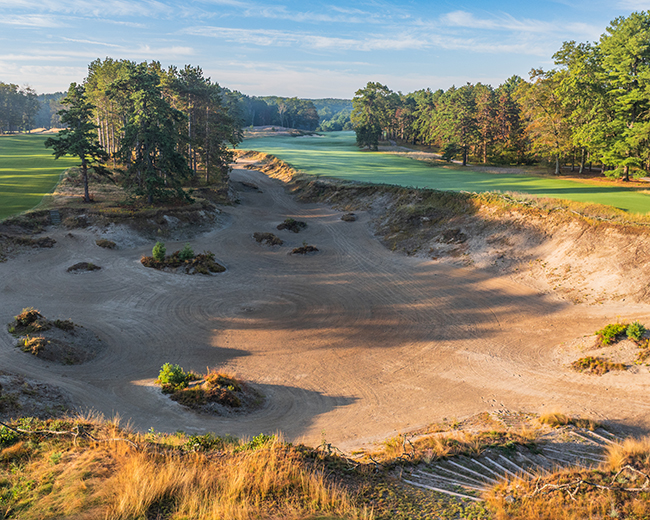Initially opened in 1901, The International in Bolton, MA, New England’s premier 36-hole facility, has undergone recent upgrades. A renovation of the club’s Tom Fazio-designed Oaks Course, led by architect Tripp Davis, was completed in 2021, followed by a rerouting and redesign of the Pines Course by Coore & Crenshaw Design, completed this year.
In 1972, Robert Trent Jones oversaw a renovation of the Pines Course. The course was lengthened to 8,325 yards and became known as America’s longest golf course. Over the past three years, the Pines Course at the International was redesigned and rerouted by Coore & Crenshaw to take better advantage of the topography, landforms, and mature vegetation. They created a totally new layout; not a single hole, corridor, or green site remains from the prior version. At 7,103 yards, the par-71 Pines course is more than 1,200 yards shorter and now more artfully draped over the land’s rolling topography, reflecting Coore & Crenshaw’s trademark emphasis on beauty, strategy, and playability.

Hole 18
Copyright @Ryan Montgomery
The strategic use of fescue grass on fairways, tees, and in the rough is a unique feature of the Pines. Balls finding the fairway can get up to 20 yards of roll. This turf, most commonly found on seaside golf courses in the British Isles, encourages shots to bounce and roll more than the grasses typically found on other golf courses in New England. Fescue also requires less frequent mowing and lower inputs of water and fertilizer.

Hole 15 Boomerang Green
@Ryan Montgomery
The greens made of 007 XL bent, a creeping bentgrass, play firmer because they’re less susceptible to disease and Poa annua intrusion. Many of the greens are canted from front-to-back, rather than the more typical back-to-front arrangement, which will further entice players to consider bouncing their approach shots into an interesting variety of hole locations. The greens themselves are relatively large, ranging from 4,200 sq. ft. (short par-3 16th) to 10,800 sq. ft. (long par-3 third). Playing corridors are pretty expansive, as the course features some 55 acres of fairways. Many of the holes are framed by pitch pine trees, a species that thrives in the sandy pockets of soil sporadically found across New England, Long Island, and New Jersey.
The fairways are generous; however, the greens are sloped and protected by deep greenside bunkers. Director of Golf Paul Celano jokingly referred to No. 16 as “the shortest par 5 in New England”. Playing at 135 yards, the bunker to the left of the 16th green is 15 feet deep, and there’s a pot bunker to the right, and the green is small. So there could be a lot of double bogey 5s.
There is no signature hole on the Pines Course. As Bill Coore stated, “to me, having a signature hole is basically saying that you spent all your efforts on that one hole. You grounded the entire golf course around one hole. Instead, we believe that every hole could be a signature hole to someone, and we are proud to say we’ve accomplished this on The Pines.”

Hole 6
@Ryan-Montgomery
Drawing inspiration from the natural beauty of the club’s 660-acre property, Coore & Crenshaw incorporated the surrounding landscape into The Pines Course, using nature to create distinctive features. The quarry around Holes 2, 3, and 13 provides beauty and requires strategic play. It adds both visual interest and depth, while showcasing the course’s secluded natural setting.
Bill Coore formed his own design firm in 1982, and Ben Crenshaw joined him later. Crenshaw is a two-time Masters champion who made his pro debut by finishing tied for 35th at Pleasant Valley CC in Sutton at the USI Classic. They’ve designed and built courses such as Sand Hills (Nebraska), Friar’s Head (New York), Cabot Cliffs (Canada), Sand Valley (Wisconsin), and Lost Farm at Barnbougle Dunes (Australia). They also designed one other course in Massachusetts, Old Sandwich GC, which opened in Plymouth in 2004.
The Pines opened for member play on June 6th and guest play on August 1st. The Pines is one of the few walking-only courses in the area, and caddies are required. In special instances, golfers can ride carts and use forecaddies, but the carts must remain on the cart paths. General manager Michael Galvin, the club’s former director of agronomy, said the fescue fairways wouldn’t tolerate cart traffic very well. Caddies are not required on the Oaks Course, the other 18-hole layout at the International.
Director of Golf Paul Paul Celano said the International has close to 325 members and that capacity presently is undecided as there will be a National membership to all Escalante golf clubs introduced. Celano said 60 percent of the membership live within 30 minutes of The International and 40 percent live outside of 30 minutes from The International, Initiation fee is $100,000, and annual dues for 2025 were $15,500.
Escalante Golf, based in Fort Worth, TX, owns 24 golf clubs and has invested over $40 million at The International. With the Pines project now completed, attention will turn to the construction of member cottages and a brand-new clubhouse.






